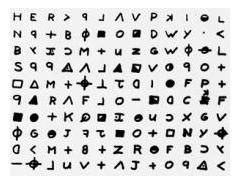As opposed to tiling the plane, here’s knitting the plane. Or, the fence.
As you can see, they’ve still got a ways to go!
And this isn’t the first example of mathematical knitting I’ve seen: check out this knitted Klein bottle!
As opposed to tiling the plane, here’s knitting the plane. Or, the fence.
As you can see, they’ve still got a ways to go!
And this isn’t the first example of mathematical knitting I’ve seen: check out this knitted Klein bottle!
 Here’s a nice feature from NewScientist magazine: Eight secret codes we still can’t crack.
Here’s a nice feature from NewScientist magazine: Eight secret codes we still can’t crack.
http://www.newscientist.com/special/unbreakable-codes
Each code–like the Kryptos monument outside CIA headquarters , or the MIT Time-Lock Puzzle–is profiled in a short article.
 Through Math for America, I am part of an on-going collaboration with the New York Times Learning Network. My latest contribution, a Test Yourself quiz-question, can be found here:
Through Math for America, I am part of an on-going collaboration with the New York Times Learning Network. My latest contribution, a Test Yourself quiz-question, can be found here:
https://learning.blogs.nytimes.com/2011/06/08/test-yourself-math-june-8-2011/
This question is based on rising gas prices and their effects on family budgets and consumer behavior.
Packing things poses some surprisingly complicated mathematical problems. Like some of the nastiest problems in math, there isn’t necessarily a standard algorithm you can use to figure out how to pack things efficiently.
I tried to put five hard-boiled eggs in a cylindrical tupperware container.
But the top wouldn’t quite close.
Perturbed, I squeezed the eggs into the cylinder in a different manner. This took some doing, as they kept falling over.
But they fit! And amazingly, they didn’t even touch the bottom!